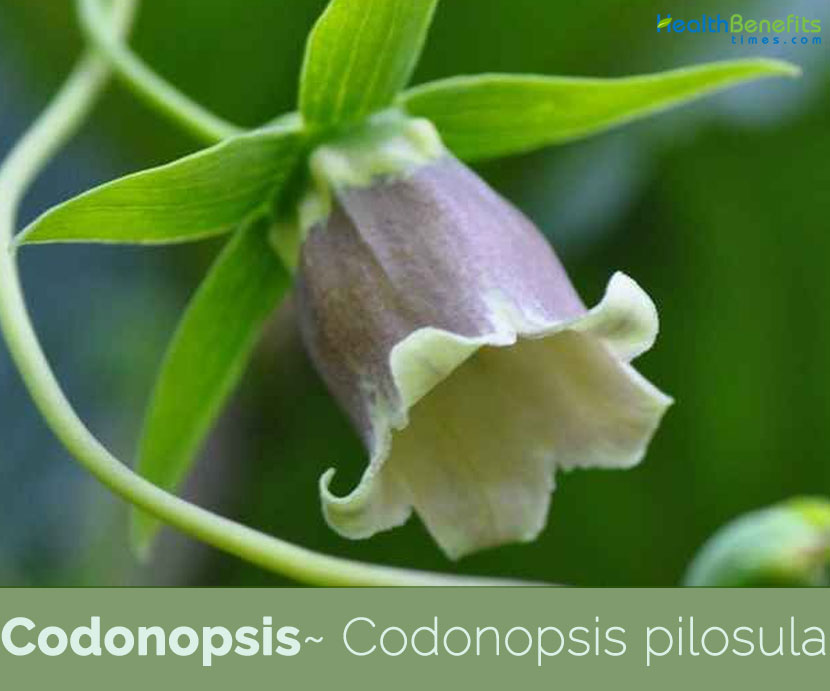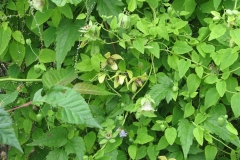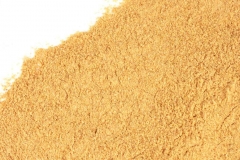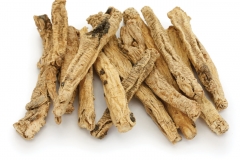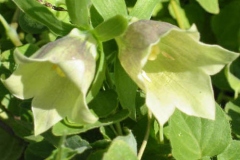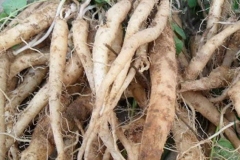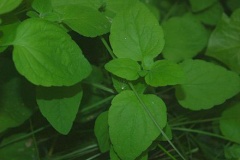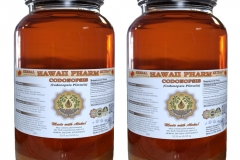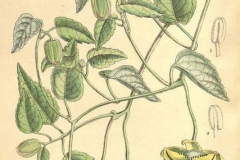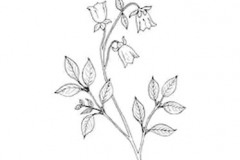Codonopsis has a central place in Chinese herbal medicine as a gentle tonic that increases energy levels and helps the body adapt to stress. Codonopsis is supposed to be similar in action to ginseng, but it is milder and has a shorter-lasting effect. It is given to those who find ginseng too strong a tonic and is used interchangeably with ginseng in Chinese herbal formulas. Research has confirmed the ability of codonopsis to help increase endurance to stress and to maintain alertness. It is no stranger to most Chinese since as this herb is a common ingredient in the everyday recipes of soups and steamed dishes. In China it is better known as Dang Shen, a major tonic for nourishing the vitality.
Codonopsis Facts
| Codonopsis Quick Facts | |
|---|---|
| Name: | Codonopsis |
| Scientific Name: | Codonopsis pilosula |
| Origin | Eastern, southern, central, and southeastern Asia |
| Shapes | Capsule up to 2.4 cm (0.9 in) long |
| Taste | Sweet |
| Health benefits | Used as Lung tonic, Stress Adaptogen, Breast-feeding tonic, Fights Fatigue, Diabetes, Chronic Illness with Weakness, Respiratory problems, Liver Diseases, Brain Boost, Beautiful Skin and Hair, |
| Name | Codonopsis |
|---|---|
| Scientific Name | Codonopsis pilosula |
| Native | Eastern, southern, central, and southeastern Asia, including China, Japan, the Russian Far East, Kazakhstan, the Indian Subcontinent, Iran, Indochina, Indonesia, etc |
| Common Names | Woodland bonnet bellflower, codonopsis, bastard ginseng, false ginseng, Dang Shen, tangshen, bonnet bellflowers, Bonnet Bellflower, Campanule à Bonnet, Chuan Dang, Codonopsis Modestae, Codonopsis Pilosula Modesta, Dong Seng, Ginseng Bâtard, Ginseng du Pauvre, Racine de Campanule à Bonnet, Radix Codonopsis, Radix Codonopsis Pilosulae |
| Name in Other Languages | Azerbaijani: Xırdatükcüklü kodonopsis, Kodonopsis Chinese: Chuan dang shen, dang shen, Tang shen Danish: Snerleklokke English: Bellflower, Dang Shen, poor man’s ginseng, Dangshen Bellflower Finnish: Kiinanpeikonkello, Peikonkellot German: Dang Shen Japanese: Hikagetsuruninjin (ヒカゲツルニンジン), Tsuruninjin zoku (ツルニンジン属) Kazakh: Ïisgül (Иісгүл) Korean: Mansam Norwegian: Cordonklokke Persian: کدنپسیس Russian: Kodonopsis (Кодонопсис) Swedish: Ginsengklocka, fattigmans ginseng Vietnamese: Đảng sâm |
| Plant Growth Habit | Herbaceous perennial twining, climbing plant |
| Growing Climates | Forests, thickets, meadows or scrub at forest margins, Dense shrubby thickets, the shade of trees at forest edges, stream banks etc |
| Soil | Thrives best in well drained neutral or acidic soil and can be planted in partially shaded or completely open areas |
| Plant Size | 5 ft. (1.5 m) |
| Root | Carrot-shaped or fusiform-cylindrical, 15-30 x 1-3 cm thick, often branched |
| Stem | Long twining stems are up to 2 m (6.6 ft.) long and branched |
| Leaf | Ovate leaves are up to 7.3 cm (3 in) centimeters long and are usually coated with short hairs |
| Flowering season | August to September |
| Flower | Bell-shaped flower is about 2 cm (0.8 in) long and wide and is yellow-green with purple spots inside |
| Fruit Shape & Size | Capsule up to 2.4 cm (0.9 in) long |
| Propagation | By seed |
| Plant Parts Used | Root, Rhizomes |
| Available Forms | Decoction, tinctures and powders |
| Taste | Sweet |
| Season | September to October |
| Health Benefits |
|
Plant Description
Codonopsis is an herbaceous perennial twining; climbing plant that normally grows about 5 ft. (1.5 m) tall. The plant is found growing in forests, thickets, meadows or scrub at forest margins, dense shrubby thickets, the shade of trees at forest edges and in stream banks etc. The plant thrives best in well drained neutral or acidic soil and can be planted in partially shaded or completely open areas. Roots are carrot-shaped or fusiform-cylindrical, about 15-30 cm long and 1-3 cm thick, often branched. Long twining stems are up to 2 m (6.6 ft.) long and branched.
In Chinese herbal medicine, codonopsis is considered to tone the qi, lungs, and spleen. It improves vitality and helps to balance metabolic function. It is a gentle tonic remedy that helps to recover the system as a whole.
Leaves
Leaves on main stems and branches are alternate, those on branchlets are opposite. Leaf-stalks are 0.5-2.5 cm long, sparsely bristly-hairy. Leaves are gray-green below, green above, ovate or narrowly ovate, 1-7.3 cm long and 0.8-5 cm wide. Leaf underside is sparsely or densely hairy, rarely hairless, base is somewhat heart-shaped, rounded, or flat, margin toothed, tip blunt or pointed.
Flowers and Fruits
The plant produces light green five pointed bell shaped flowers with prominent yellow or light purple veins. Flowers are yellow-green, with purple spots inside, broadly bell-shaped, 1.8-2.3 cm long and 1.8-2.5 cm wide, shallowly lobed. Lobes are triangular, tip pointed. Filaments are slightly dilated at base, about 5 mm; anthers elongate, 5-6 mm. Stigma is white bristly. Sepal cup is adnate to ovary up to middle. Sepals are broadly lance shaped or narrowly oblong, 1.0-2.3 cm x 6-8 mm, margin sub entire or sinuate, apex obtuse or acute; sinus between calyx lobes narrow and pointed. Fertile flowers are followed by fruit capsule that is up to 2.4 cm (0.9 in) long with persistent calyx and small, oval, brown and shiny seeds. The plant blooms from August to September and fruits from September to October.
Codonopsis is taken in particular for tired limbs, general fatigue, and for digestive problems such as appetite loss, vomiting, and diarrhea. It is beneficial in any chronic illness where “spleen qi deficiency” is a contributory factor. Codonopsis is given as a tonic to people who are stressed and have “false-fire” symptoms, including tense neck muscles, headaches, irritability, and high blood pressure, and who find the tonic action of ginseng too strong. Codonopsis is supposedly more successful in reducing levels of adrenaline, and therefore stress, than ginseng.
Health benefits of Codonopsis
Bellflower plant has several benefits and has been used as food or herb by Asian countries for countless centuries. Although Western medicine was obstinately doubtful about the health benefits of many plants and herbs used in Asia, the good news is that the science is starting to catch up. There have been some research done lately that have shown that this bellflower plant has sufficient of health benefits. Listed here are some of the popular health benefits of codonopsis
1. Used as Lung tonic
Codonopsis helps to relieves chronic coughs, shortness of breath and chronic excessive phlegm of the Lungs and sinuses. In cases of dryness and heat of the Lungs, Codonopsis has a moistening effect on the tissue. It also helps to ease asthma attacks by decreasing the production of hormones that cause constriction of the bronchia passages.
2. Breast-feeding tonic
The herb is taken regularly by nursing mothers in China to increase milk production and as a tome to “build strong blood.”
3. Diabetes
The plant is one of the traditional Chinese medicinal herbs used in treating diabetes and reducing the complications that arise from diabetes. Research in the Journal of Ethno pharmacology, traditional Chinese medicinal herbs flashed abundant interest because they may be vital for treating severe chronic diseases like diabetes while producing fewer side effects than most conventional medications. They also cost less and offer better patient tolerance than pharmaceutical drugs. According to this study, it lowers blood glucose considerably.
4. Respiratory problems
Codonopsis clears excessive mucus from the lungs and is useful for respiratory problems, including shortness of breath and asthma.
5. Liver Diseases
Codonopsis help to protect against alcoholic fatty liver disease according to a research published in the “Journal of Medicinal Food.” In traditional Chinese medicine it is used to lower high blood pressure which would recommend that it benefits the Liver.
6. Brain Boost
Codonopsis combined with ginkgo biloba help to enhance memory and learning better than using gingko biloba only. Research result published in the Alternative Therapies in Health and Medicine to determine the usefulness of several Chinese herbs showed that mixing C. pilosula with G. biloba produced better results than G. biloba alone.
7. Beautiful Skin and Hair
Codonopsis builds blood, particularly red blood cells and hemoglobin. Additionally, it cleanses the blood providing for smooth, elastic and radiant skin. It also expands blood vessels and lowers blood pressure.
8. Stress Adaptogen
It is considered as an adaptogenic herb due to its ability to strengthen the body’s ability to adapt to change, moderate stress and balance metabolic functions of the body.
9. Fights Fatigue
Possibly because of its immune enhancing effects and its ability to boost the blood supply, Dang shen has long been used to treat general fatigue as well as illnesses that weaken the body like anemia.
10. Chronic Illness with Weakness
It has traditionally been used with extreme debility, weakness and wasting disorders, particularly where there is damage to the fluids of the body demonstrating heat signs (fever/thirst). It fortifies the immune system and not only supports the immune functions in cancer patients, but also protects the cells in the body from the damaging effects of radiation. It has not been determined if codonopsis may cause drug-herb interactions with patients utilizing chemotherapy.
Traditional uses and benefits of Codonopsis
- Dang Shun is an important herb in Chinese medicine; it is a gentle tonic that increases energy levels and helps the body adapt to stress.
- Root consists of saponins, triterpenes and steroids; it is similar in action to ginseng.
- It is a sweet, warm, soothing herb that is taken as an energy tonic.
- It acts mainly on the spleen, lungs and stomach, raising secretion of body fluids and blood sugar levels, and encouraging the immune system.
- Research has shown that it increases hemoglobin and red blood cell levels and lowers the blood pressure.
- It also helps increase endurance to stress and promotes alertness.
- Root and the whole plant are adaptogen, appetizer, digestive, galactogogue, sialagogue, stomachic and tonic.
- It is taken internally in the treatment of low energy, poor appetite and digestion, anemia, shallow breathing and debility after illness.
- It is often cooked with rice until it is glutinous and used as a tonic food.
- Dried root is decocted with other herbs and used to treat a wide range of ailments.
- Roots of plants at least three years old are harvested in the autumn and can be used fresh or dried.
- It acts mainly on the spleen, lungs and stomach, raising secretion of body fluids and blood sugar levels, lowering the blood pressure and stimulating the immune system.
- It is also thought to be helpful for diarrhea, vomiting, flatulence and excessive stomach acid.
- Other ailments that have been treated with dang shen are a headache (when it is due to high blood pressure, muscle tension or indigestion), chronic cough and shortness of breath.
- The herb is considered to have blood building properties and to be effective in reducing chronic fatigue syndrome.
- It is also used as a styptic agent in cases of uterine bleeding and excessive menstruation.
- It has also been used as an herbal remedy for arthritis and other conditions of the muscles and joints.
- Codonopsis remedies have been used in the treatment of asthma and even cancer.
- Codonopsis remedies also increase stamina and endurance.
- In this Asian system of herbal medication, codonopsis is used to alleviate headaches that come along with high blood pressure problems.
- TCM practitioners also suggest codonopsis remedies to relieved tension in the muscles, as well as an aid in treating indigestion and related abdominal disorders.
- Codonopsis remedies have also been used in the treatment of the auto-immune disorder known as lupus.
- Codonopsis remedies have also been used to treat peptic ulcer and other ulcerations in the body.
- Codonopsis in the form of an astringent is used to heal abundant uterine bleeding and also to treat rheumatic as well as other types of aching joints.
Culinary Uses
- Roots can be consumed raw or cooked.
- Roots of codonopsis are often added to soups like a carrot, and in breakfast cogees or oatmeal for its health benefits.
- It is often ground into flour, boiled with rice, added to soups and used as an ingredient in nourishing teas.
Dosage and Administration
The common dosage of poor man’s ginseng is 6-15 g when it is used in conjunction with other herbs in decoction, extracts or powders. If it is used on its own, the dosage may be as high as 30-60 g daily.
Other Facts
- Roots are harvested from the plant during the third or fourth year of growth and dried prior to sale.
- Root is also used as a gentler and more economical substitute for Panax ginseng.
- It is a sweet, warm, soothing herb that is taken as an energy tonic.
- The herb is also known as ‘poor man’s ginseng’ because it shares many of the same health benefits but is sold at a much cheaper price.
Immune Boosting Rice
Ingredients
- Half of one onion, minced
- 4 cloves of garlic, minced or grated
- 2 cups brown rice
- 1 quart chicken broth, preferably homemade
- 2 teaspoons turmeric, freshly grated
- 2 teaspoons ginger, freshly grated
- 4 ounces fresh shiitake mushrooms, sliced thinly
- 2 large or 6 small Astragalus root slices, dried
- 2 large or 2 tablespoons small codonopsis root pieces, dried*
- Salt and pepper to taste
Directions
- Add all the ingredients to a medium sauce pan and simmer 30 minutes or until the water is fully absorbed.
- Remove the Astragalus and codonopsis slices before serving.
Precautions
- It may cause Dizziness.
- Avoid in individuals with a known allergy or hypersensitivity to Codonopsis pilosula.
- It must be used carefully in patients with bleeding disorders or who are taking anticoagulant or anti-platelet agents.
- It should be used cautiously in patients who are taking laxatives or stool softeners or who have inflamed bowel or appendicitis.
- Use thoughtfully in patients using antacids or gastric re-flux medications, as Codonopsis pilosula may reduce gastric acid-pepsin secretion.
- Use cautiously in patients using oral medication, as Codonopsis pilosula extract may prevent gastrointestinal movement.
- Avoid using in women who are trying to become pregnant.
- Codonopsis may slow down blood clotting and increase the risk of bleeding. People with bleeding disorders should avoid using the herb.
- Because it can slow down blood clotting, you should not use the herb in the run up to a scheduled surgery.
References:
https://www.itis.gov/servlet/SingleRpt/SingleRpt?search_topic=TSN&search_value=845379#null
https://pfaf.org/user/plant.aspx?latinname=Codonopsis+pilosula
https://plants.usda.gov/core/profile?symbol=COPI8
https://npgsweb.ars-grin.gov/gringlobal/taxonomydetail.aspx?id=464993
https://en.wikipedia.org/wiki/Codonopsis_pilosula
http://www.theplantlist.org/tpl1.1/record/kew-367867
https://www.flowersofindia.net/catalog/slides/Dangshen%20Bellflower.html
http://temperate.theferns.info/plant/Codonopsis+pilosula
https://davesgarden.com/guides/pf/go/218067/#b


